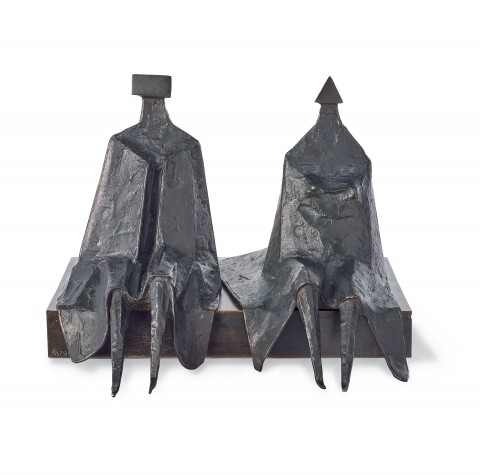SITTING FIGURES IN ROBES II, 1980
LYNN CHADWICK
bronze figures on a bronze base
26.5 x 31.5 x 28.5 cm (including base)
each figure stamped with artist’s monogram and numbered on underside: C 788 6/9 & C 788 6/9
bronze base stamped with artist’s monogram and numbered: C 788 6/9
Dennis Hotz Gallery, Johannesburg, South Africa
Private collection, Sydney, acquired from the above
Thence by descent
Private collection, Sydney
Lynn Chadwick and Karolus Lodenkämper, Fondation Veranneman, Kruishoutem, Belgium, October – December 1980 (another example)
Farr, D., and Chadwick, E., Lynn Chadwick, Sculptor: With a Complete Illustrated Catalogue 1947 – 2005, Lund Humphries, United Kingdom, 2000, cat. 788, pp. 326 – 327 (illus., another example)
We are grateful to Sarah Chadwick for her assistance with this catalogue entry.
‘Art must be the manifestation of some vital force coming from the dark, caught by the imagination and translated by the artist’s ability and skill… Whatever the final shape, the force behind is… indivisible. When we philosophise upon this force, we lose sight of it. The intellect alone is too clumsy to grasp it.’1
Like his much-admired predecessors and contemporaries such as Henry Moore, Alexander Calder, Alberto Giacometti and Barbara Hepworth, Lynn Chadwick is widely regarded as one the twentieth century’s greatest sculptors. Fusing extraordinary imagination with immense technical ability, his art is revered for its remarkable ability to both respond to, and transcend, its time; as Terence Mullaly reflected in his obituary of the artist, ‘…he produced objects eloquent of both the grandeur and the dilemma of man. They are highly idiosyncratic, yet their message is universal.’2 Born in London in 1914, Chadwick studied architectural drafting and design after his World War II service as a pilot, before emerging during the fifties as a sculptor with a singularly distinctive and dramatic style. Following two solo exhibitions at Gimpel Fils, London, he was propelled to fame in 1952 as one of seven young British sculptors invited to exhibit at the British Pavilion of the Venice Biennale in 1952, and in 1956, was awarded the Biennale's highest honour - the prestigious International Prize for Sculpture. Over the subsequent decades, Chadwick has exhibited to widespread acclaim in Paris, London, New York and Tokyo, and today is represented with works in most major international collections, including the Museum of Modern Art, New York; the Tate Gallery, London; the Musée National d'Art Moderne, Paris; and the Art Gallery of New South Wales, Australia.
Although Chadwick's first creations were – quite appropriately, given his flying experience – abstract mobiles and elegant suspended constructions of metal and glass, it is his timeless architectonic forms combining elements of the human, animal and mechanical such as Sitting Figures in Robes II, 1980, for which he is most highly acclaimed. Evolving from the brooding standing figures of the sixties, and the voluminous, striding figures of the seventies onwards, the present bronze is an impressive example of the artist's seated figure motif which, though punctuating his entire oeuvre to a certain degree, culminates during this decade – most famously in his monumental Back to Venice, 1988, commissioned by the British Council for the XLIII Venice Biennale in memory of the artist’s extraordinary achievement thirty-two years earlier. Reminiscent of Ancient Egyptian sculptural portraits of royal married couples with their distinctly regal air and direct frontality, Sitting Figures in Robes II, 1980 explores the tensions and relationships that arise between two forms when juxtaposed alongside one another. Like the Egyptian examples, there is similarly a clear division of gender here – the woman is more lightly built, her shoulders sloping at a gentler angle and her body appearing rounder than her male partner who occupies a weightier stance, his mass and angularity more forcefully expressed, with the addition of a deep fissure to his torso revealing a sharper sense of form. If there were any ambiguity, Chadwick moreover incorporates iconic symbols from his idiosyncratic artistic vocabulary – the geometric square or rectangle denoting the male character, while the triangular or pyramidal shape identifies the female.
Although betraying no real narrative or emotional timbre – the figures here neither touch one another, nor engage in eye contact - there is nevertheless a tangible sense of shared intimacy or connectedness, as their magisterial bodies seem to respond and reflect one another across the precisely judged gap which separates them. Thus capturing the rarefied essence of something human, universal, contemplative and at times, elegiac, Sitting Figures in Robes II invariably beguiles and attracts, drawing in the viewer yet at the same time, revealing little. Like the best of Chadwick’s mysterious works, the sculpture remains powerfully elusive in its anonymous strength and silent presence – and perhaps that is the point. As the artist himself – notoriously reluctant to assign specific meaning to his work – elaborates, '...The important thing in my figures is always the attitude – what the figures are expressing through their actual stance. They talk, as it were, and this is something a lot of people don't understand...’3
1. Chadwick, L., The Listener, London, 21 October 1954
2. Mulally, T., ‘Lyn Chadwick’, The Guardian, Monday 28 April, 2003, p. 5
3. Chadwick cited at http://www.gallerycenter.org/elaine_baker_chadwick.shtml
VERONICA ANGELATOS
